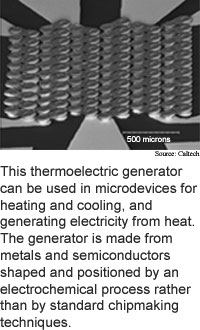
Metal process makes heat chips
Researchers from the California Institute
of Technology have found a way to make tiny thermoelectric devices that
can be used to generate electrical power from heat and to cool very small
areas.
The devices could eventually be used to very quickly cool tiny amounts
of chemicals on labs-on-a-chip, to cool optoelectronics devices, and to
power devices like wristwatches and portable electronics, according to the
researchers.
The key to making the devices, which contain hundreds of separate
pieces, is an electrochemical process that forms parts from several different
types of metal and semiconductor materials. In contrast to commercial fabrication
processes used to fashion the microscopic transistors that make up computer
chips, the researchers' method allows for the use of metal.
The method involves using molds to deposit films of dissolved metals
and semiconductors, then reducing the films to form solids. The molds, which
are made from non-conducting material, allow the researchers to fabricate
relatively tall structures from electrically-conducting materials.
The method could be used in practical cooling and power applications
in two to five years, according to the researchers. The work appeared in
the July 27, 2003 issue of Nature Materials.
Software speeds modeling
DNA plays tic-tac-toe
Email updates six degrees theory
Cellophane turns LCDs 3D
News briefs:
Detector senses single DNA
Crystal shortens infrared waves
Tool sketches quantum circuits
Nanotubes spark gas detector
Metal process makes heat chips
Light makes molecule shine

Research Watch blog
View from the High Ground Q&A
How It Works
RSS Feeds:
News
Ad links:
Buy an ad link
Ad links: Clear History
Buy an ad link
|
TRN
Newswire and Headline Feeds for Web sites
|
© Copyright Technology Research News, LLC 2000-2010. All rights reserved.